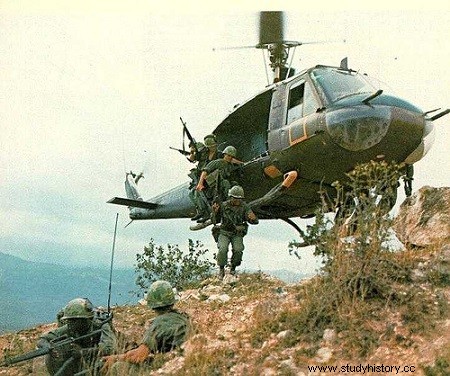
On October 19, 1965, General Chu launched the Tau Nguyen campaign by attacking the Special Forces camp at Plei Me, about 30 km south of the provincial capital, Pleiku. General William Westmoreland, head of U.S. military assistance to Vietnam, ordered Major General H.W.O. Kinnard to send its 1st Div. of Cav. in order to help the South Vietnamese clear the attacked camp and pursue the enemy, but when the 1st Bde. of the Div. arrived on the spot, the assailants had disappeared. Kinnard and his intelligence officers suspected them of retreating to their safe haven and sent Sqn. of divisional recognition their research. Slipping between the trees and the ravines, the light observation helicopters spotted the enemy 10 km west of the camp, which resulted in the capture of a North Vietnamese field hospital. During the struggle for the hospital and other raids, the relatively inexperienced Americans learned that the North Vietnamese were well equipped, resolute and dexterous. When the Americans established a defensive perimeter, the North Vietnamese managed to get so close that the defensive fires lost all effectiveness. Then, they shot down or attacked the stunned riders at distances less than 10 m. These, however, made rapid progress and, in the fight for the hospital, shot down 78 North Vietnamese and took 57 prisoners for a loss of 5 killed and 18 wounded.
Preparing for an ambush
South Vietnamese and American intelligence were convinced that the bulk of Chu's forces were busy rebuilding to the west, beyond the Drang River Valley to the Chu Pong Mountains on the Vietnamese side of the border. This area had been a Viet Minh hideout, and friendly forces rarely ventured there. On November 2, 1965, the 1st Sqn. of the 9th of Cav. landed in a small open area which was dubbed "Mary's Landing Area" and set up an ambush on the slopes of the hills descending from the Chu Pong massif towards the La Drang. It was the first time that Div. attempted a night ambush with setting up by air, an ambush which was to be exploited by a company. of Inf. also brought at night. In this operation, the casualty report was 150 North Vietnamese killed against 4 killed and 25 wounded on the American side. Chu's forces were well in the area, and Cav. of the air, having started the fight, gave way to the bulk of the Div. to finish it off.
By November 9, Chu's men were divided into two main areas:the 32nd Regt. North Vietnamese was on the north bank of the La Drang in the vicinity of Cambodia while the 66th, Chu's main asset, and the 33rd were between the river and the eastern foothills of the Chu Pong. The 66th was in fine condition but the 33rd had lost a third of its strength of 2,200 men in the fighting for Plei Me; so it had reorganized into a Bn. composite, but a Bn. which was almost the size of a Regt. Chu's 120mm mortars and twin 14.5mm AA machine guns were still on the trail – Ho Chi Minh in Cambodia. Safe on the rocky and forested foothills, Chu prepared for a new attack on Plei Me.
The men of 3rd Bde. of 1st Div. of Cav. commanded by Colonel T.W. Brown, were looking for Chu's hideout. Among his Bns. of combat, this Bde. had two of the famous 7th of Cav. US. For this reason the Bde. had adopted the motto of the 7th:"Garry Owen", and its spirit. The comic. began by searching large swathes of the valley, hiring squads and Sons. practicing the system of saturation by patrols, but as the excavations near the massif seemed full of promise, Lieutenant-Colonel H.G. Moore, commanding the 1st Bn. of the 7th Cav., decided to look for a landing zone where he could put his Bn. en masse.
